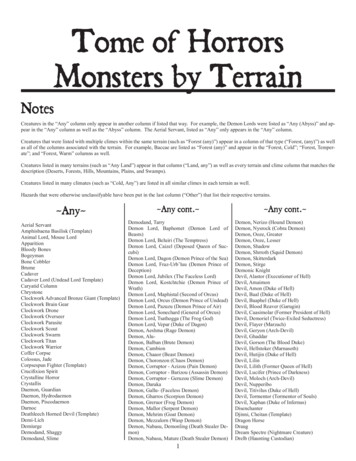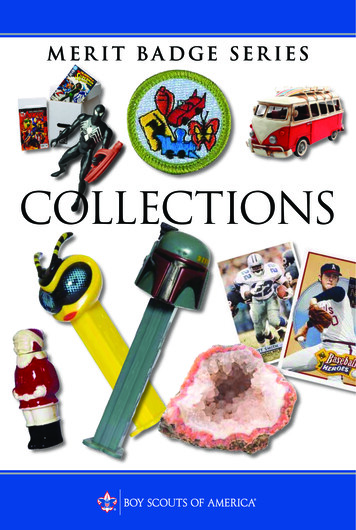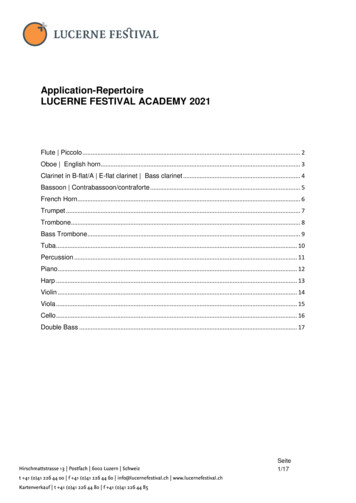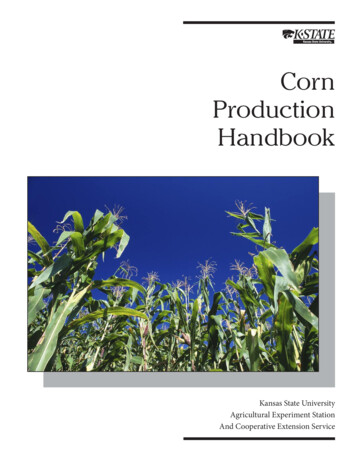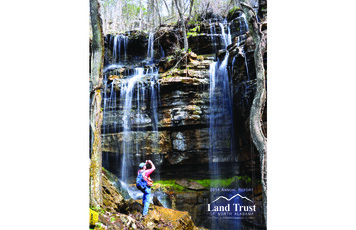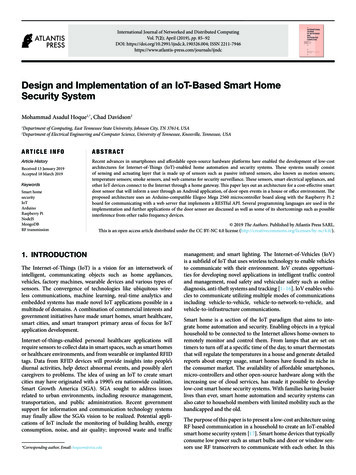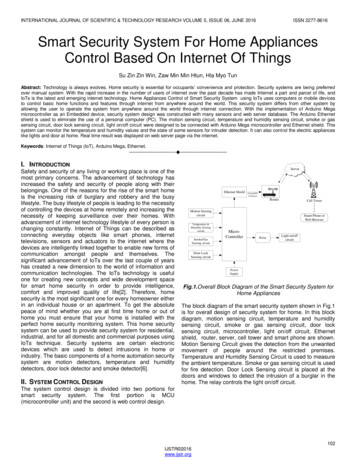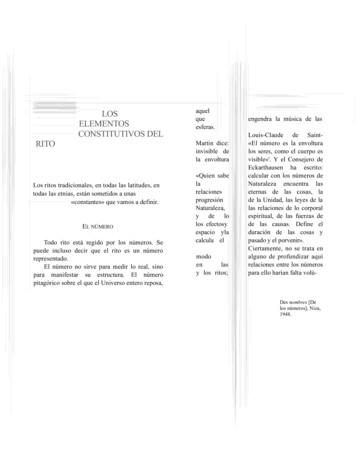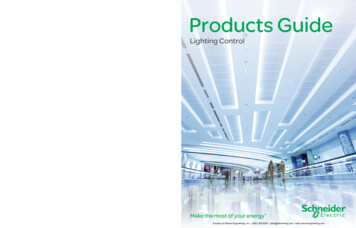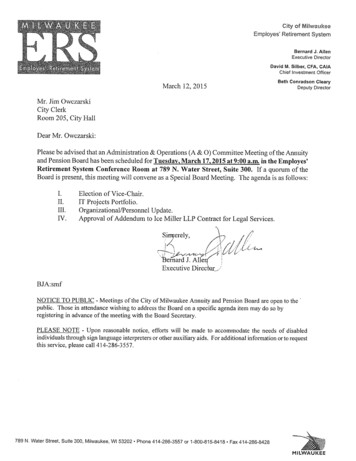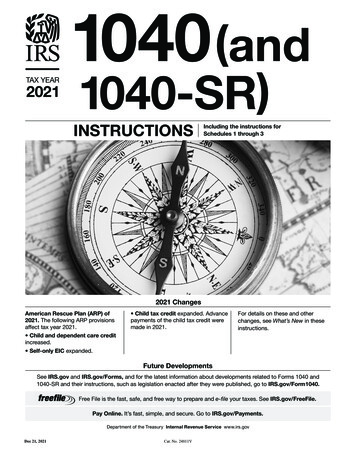
Transcription
Lucerne fleaSminthurus viridisclick for html versionOther common names: Clover springtailSummary:The lucerne flea is an introduced pest commonly found in New South Wales, Victoria, Tasmania,South Australia and Western Australia. It is a green-yellow globular insect commonly found inbroadleaf crops and pastures. Lucerne fleas have a furcula underneath their abdomen that acts like aspring and enables them to ‘spring off’ vegetation when disturbed. Synthetic pyrethroid spraysshould be avoided. Grazing management, border sprays or spot spraying may be sufficient to controllucerne flea populations.Occurrence:Lucerne fleas (sometimes also known as clover springtails) are common pests found in New SouthWales, Victoria, Tasmania, South Australia and Western Australia. Higher numbers are often found inthe winter rainfall areas of southern Australia, including Tasmania, or in irrigation areas wheremoisture is plentiful. They are generally more problematic on loam/clay soils. Lucerne fleas are oftenpatchily distributed within paddocks and across a region.The known distribution of lucerne flea in Australia (Source: cesar)
Description:The lucerne flea is a springtail; this is a group of arthropods that have six or fewer abdominalsegments and a forked tubular appendage or furcula under the abdomen. Springtails are one of themost abundant of all macroscopic insects and are frequently found in leaf litter and other decayingmaterial, where they are primarily detritivores. Very few species, including the lucerne flea, areregarded as crop pests around the world.The adult lucerne flea is approximately 3 mm long, light green-yellow in colour and often withmottled darker patches over the body. They are wingless and have enlarged, globular shapedabdomens. They are not related to true fleas. Newly hatched nymphs are pale yellow and 0.5-0.75mm long, and as they grow they resemble adults, but are smaller.Adult lucerne flea (Source: cesar)Distinguishing characteristics/description of the Lucerne flea (Bellati et al. 2012)Lifecycle:Female lucerne fleas lay their eggs in the ground in batches of 20-60. Newly hatched nymphsgenerally resemble adults but are only about 0.75 mm long and pale yellow in colour. Depending on
temperatures and moisture availability, lucerne fleas can have up to 6 generations per year betweenautumn and spring. The length of each generation can be from 3-5 weeks. The first generation oftenhatches from over-summering eggs in March-April after soaking autumn rainfall. In mid to latespring lucerne fleas die off from the onset of warmer weather leaving over-summering eggs on soilsurface. The rate of growth of lucerne flea populations is very moisture dependent; they do well inmoist conditions or under dense canopies of pasture.Behaviour:Lucerne fleas have a furcula underneath their abdomen, which acts like a spring and enables them to’spring off’ vegetation when disturbed. This pest is distinctively patchy in distribution. These patchesof intense feeding can move around paddocks, and can be obvious targets of spot spraying.Similar to:Other springtails (Collembola), including other plant-feeding springtails that are more solitary inhabit.Crops attacked:All crops and pastures, but broadleaf plants including lucerne and clover are particularly susceptibleto attack. Capeweed is a favoured weed host. They can also cause considerable damage to canola,field peas, lupins, faba beans, ryegrass, wheat and barley.Damage:Lucerne fleas move up plants from ground level, eating tissue from the underside of foliage. Theyfeed through a rasping process, leaving behind a thin clear layer of leaf membrane that appears astransparent ‘windows’ through the leaf. In severe infestations this damage can skeletonise the leafand stunt or kill plant seedlings. Crops and pastures are most susceptible at the time of emergence.Lucerne fleas feed through a rasping process, which results in the characteristic appearance offeeding ‘windows’ through the leaf.Typical lucerne flea feeding damage to clover (source: cesar)
Monitoring:Crops should be inspected frequently at, and immediately following crop emergence, when plantsare most susceptible to damage. Pastures should be monitored at least fortnightly from autumn tospring, and more often in paddocks with previous lucerne flea problems. Lucerne fleas are oftenconcentrated in localised patches so it is important to monitor paddocks entirely. Examine foliagefor feeding damage, and check the soil surface for sheltering insects. An effective way to samplelucerne fleas is to use a standard petrol powered garden blower/vacuum machine. A fine sieve orstocking is placed over the end of the suction pipe to trap mites vacuumed from plants and the soilsurface.Lifecycle, critical monitoring and management periods for the lucerne flea (Source: cesar and QDAFF)Economic thresholds:As a guide, an average of 20 small holes per trifoliate legume leaf may warrant chemical control. Ifpasture is severely damaged it may be cost effective to spray (Bailey 2007).Management options:Biological:The pasture snout mite and spiny snout mite are effective predators, particularly in pastures wherethey can prevent pest outbreaks. Spiders and ground beetles also prey on lucerne flea. The complexof beneficial species should be assessed before deciding on control options.Cultural:Grazing management by reducing the height of pasture will limit food resources and increasemortality of lucerne fleas. Control broadleaf weeds (e.g. capeweed) to remove alternative foodsources that would otherwise assist in population build up. In pastures, avoid clover varieties thatare susceptible to lucerne flea damage, and avoid planting susceptible crops such as canola andlucerne into paddocks with a history of lucerne flea damage.Grazing pastures in late spring to reduce lucerne flea habitat in problematic areas can reducedamage.Chemical:If the damage warrants control, treat the infested area with an insecticide three weeks after lucernefleas first emerge in autumn. This will allow for the further hatching of over-summering eggs but will
be before they reach maturity and begin to lay winter eggs.Lucerne fleas have a high natural tolerance to synthetic pyrethroids and should not be treated withinsecticides from this chemical class. In paddocks where damage is likely, a border spray may besufficient to prevent movement of lucerne fleas into the crop from neighbouring paddocks. Lucernefleas are often patchily distributed within crops, so spot spraying may be sufficient. Do not blanketspray unless the infestation warrants it.A border spray or spot spraying may be sufficient to control lucerne flea numbers. Syntheticpyrethroid sprays should be avoided.Acknowledgements:This article was compiled by Paul Umina, Garry McDonald and Sandra Hangartner (cesar).References:Bailey PT. 2007. Pests of field crops and pastures: identification and control. CSIRO Publishing, Melbourne.Bellati J, Mangano P, Umina P and Henry K. 2012. I SPY. Insects of Southern Australian Broadacre Farming SystemsIdentification Manual and Education Resource. Department of Primary Industries and Resources South Australia (PIRSA),the Department of Agriculture and Food Western Australia (DAFWA) and cesar Pty Ltd.Bishop All, Harris AM and McKenzie. 2001. Distribution and ecology of the lucerne flea, Sminthurus viridis (L.) (Collembola:Sminthuridae), in irrigated lucerne in the Hunter dairying region of New South Wales. Austral Entomology 40: 49-55.Bishop A, Hopkins D and Castleman L. 2002. Knowledge, timing, key to lucerne flea control. GRDC Advice Sheet SouthernRegion. ea nov02.pdfGreenslade P. 2014. The potential of Collembola to act as indicators of landscape stress in Australia. Australian Journal ofExperimental Agriculture 47: 424–434.Greenslade P. 2015. Australian springtails: Tiny titans of the earth. Wildlife Australia 51: 9-13.Gu H, Fitt GP and Baker GH. 2007. Invertebrate pests of canola and their management in Australia: a review. AustralianJournal of Entomology 46: 231-243.Murray DAH, Clarke MB and Ronning. 2013. Estimating invertebrate pest losses in six major Australian grain crops.Australian Journal of Entomology 52: 227-241.Roberts J and Umina P. 2008. Lucerne Flea. AG0415. Victorian Department of Primary -mites/lucerne-fleaRoberts JMK, Umina PA, Hoffmann AA and Weeks AR. 2009. The tolerance of the lucerne flea, Sminthurus viridis, tocurrently registered pesticides in Australia. Australian Journal of Entomology 48: 241-246.Roberts JMK, Umina PA, Hoffmann AA and Weeks AR. 2011. Population dynamics and diapause response of the springtailpest, Sminthurus viridis (Collembola: Sminthuridae), in south-eastern Australia. Journal of Economic Entomology 104: 465473.Roberts JMK, Weeks AR, Hoffmann AA and Umina P. 2011. Does Bdellodes lapidaria (Acari: Bdellidae) have a role inbiological control of the springtail pest, Sminthurus viridis (Collembola: Sminthuridae) in south-eastern Australia? BiologicalControl 58: 222-229.Roberts JMK and Weeks AR. 2011. Genetic structure and long-distance dispersal in populations of the wingless pestspringtail, Sminthurus viridis (Collembola: Sminthuridae). Genetics Research 93: 1-12.Version control:DateMar-15Version1Compiled byPaul Umina (cesar), SandraHangartner and GarryMcDonald (cesar)Reviewed ByAlana Govender (cesar) andBill Kimber (SARDI)
What are PestNotes?PestNotes are information sheets developed through a collaboration between cesar and the SouthAustralian Research and Development Institute (SARDI). Copyright: All materia l published in PestNotes iscopyright protected by cesar and SARDI and may not be reproduced in any form without written permissionfrom both agencies.Disclaimer:The material provided in PestNotes is based on the best available information at the time of publishing. No personshould act on the basis of the contents of this publication without first obtaining independent, professional advice.PestNotes may identify products by proprietary or trade names to help readers identify particular products. We donot endorse or recommend the products of any manufacturer referred to. Other products may perform as well asor better than those specifically referred to. cesar and PIRSA will not be liable for any loss, damage, cost or expenseincurred or arising by reason of any person using or relying on the information in this publication. Any research withunregistered pesticides or products referred to in PestNotes does not constitute a recommendation for thatparticular use.
An effective way to sample lucerne fleas is to use a standard petrol powered garden blower/vacuum machine. A fine sieve or stocking is placed over the end of the suction pipe to trap mites vacuumed from plants and the soil surface. Lifecycle, critical monitoring and management periods for the lucerne flea (Source: cesar and QDAFF)
